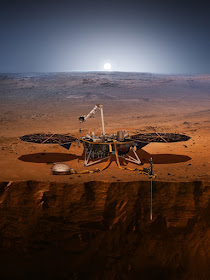SpaceX - Dragon CRS-14 Mission patch.
May 5, 2018
SpaceX's Dragon cargo spacecraft splash down in the Pacific Ocean today, Saturday May 5, west of Baja California, with more than 4,000 pounds of NASA cargo, science and technology demonstration samples from the International Space Station.
The Dragon spacecraft will be taken by ship to Long Beach, where some cargo will be removed immediately for return to NASA. Dragon then will be prepared for a return trip to SpaceX's test facility in McGregor, Texas, for final processing.
Image above: The SpaceX Dragon splashes down in the Pacific Ocean in May of 2016 after resupplying the Expedition 47 mission. Image Credit: SpaceX.
A variety of technological and biological studies are returning in Dragon:
Samples from the Metabolic Tracking study will help researchers understand the effects of microgravity on the metabolic impact of five different therapeutic compounds. This investigation determines the feasibility of developing improved pharmaceuticals in microgravity using a new method to test the metabolic impacts of drug compounds. This could lead to more effective, less expensive drugs.
The APEX-06 investigation studied the growth, development, and gene expression profiles of seedlings from the monocot Brachypodium distachyon. Most major cereal grain crops used to produce food belong to a class of plants called monocotyledons or monocots, flowering plants whose seeds typically contain only one embryonic leaf. This investigation will lead to a better understanding of the molecular and developmental mechanisms that contribute to adaptation to spaceflight conditions. In the long term, results may also lead to the development of strategies aimed at improving monocot adaptability to spaceflight parameters, which would be beneficial for future human space exploration as monocots provide many food staples.
Dragon waiting its recovery. Image Credit: SpaceX
Fruit Fly Lab–03 is the third mission of the Fruit Fly Lab aboard the station using the model organism Drosophila melanogaster. Drosophila are used for research because approximately 75 percent of human disease genes have analogs in the fruit fly genome. This mission studied the effects of the space environment on innate immunity, which is the branch of the immune system responsible for quick, non-specific responses to infection. This subject is important for preparing for future exploration as immune system dysfunction and infections are potential risks for astronauts on long-duration space exploration missions.
Dragon is the only space station resupply spacecraft currently capable of returning cargo to Earth, and this was the second trip to the orbiting laboratory for this spacecraft, which completed its first mission nearly two years ago. SpaceX launched its 14th NASA-contracted commercial resupply mission to the station April 2 from Space Launch Complex 40 from Cape Canaveral Air Force Station in Florida on a Falcon 9 rocket that also previously launched its 12th NASA-contracted commercial resupply mission to the station.
For more than 17 years, humans have lived and worked continuously aboard the International Space Station, advancing scientific knowledge and demonstrating new technologies, making research breakthroughs not possible on Earth that will enable long-duration human and robotic exploration into deep space. A global endeavor, more than 200 people from 18 countries have visited the unique microgravity laboratory that has hosted more than 2,300 research investigations from researchers in more than 100 countries.
Related links:
Metabolic Tracking: https://www.nasa.gov/mission_pages/station/research/experiments/explorer/Investigation.html?#id=7517
APEX-06: https://www.nasa.gov/mission_pages/station/research/experiments/explorer/Investigation.html?#id=7524
Fruit Fly Lab–03: https://www.nasa.gov/ames/research/space-biosciences/fruit-fly-lab-03-spacex-14
Commercial Resupply: http://www.nasa.gov/mission_pages/station/structure/launch/index.html
Space Station Research and Technology: https://www.nasa.gov/mission_pages/station/research/index.html
International Space Station (ISS): https://www.nasa.gov/mission_pages/station/main/index.html
Images (mentioned), Text, Credits: NASA/Mark Garcia.
Greetings, Orbiter.ch















































